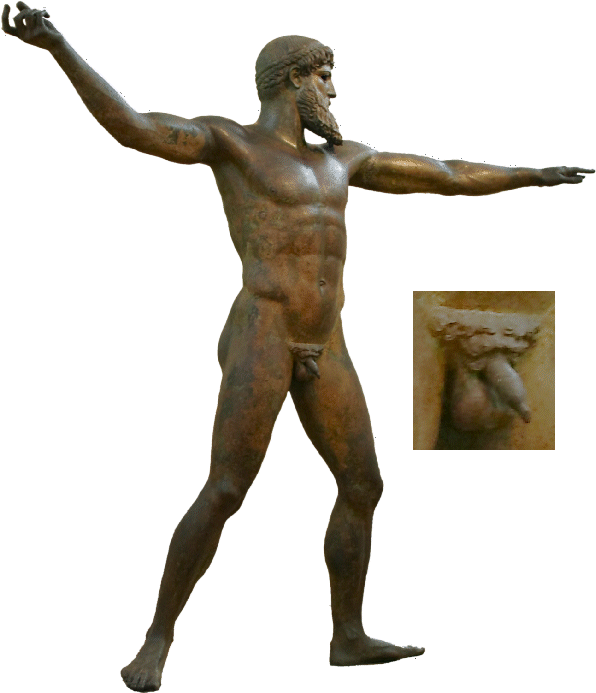
Poseidon throwing a trident (some say Zeus throwing a thunderbolt), more than 2450 years old, fished out of Cape Artemisium in 1928, now an icon of Greece.
These pictures are intended for USAmerican women and others who may have never seen intact ("uncircumcised") penises before - or not known what they were looking at.
|
This entire sequence - the next five pages - has been turned into a slide show with music, off-site. |
1. Classical Antiquity

Poseidon throwing a trident (some say Zeus throwing a thunderbolt), more than 2450 years old, fished out of Cape Artemisium in 1928, now an icon of Greece.
bronze, 210cm
Athens, Archeological Museum
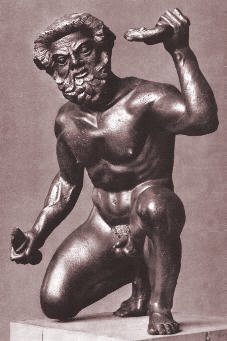 |
|
|
This bronze satyr killing a snake, 44 cm high and 2350 years old, is from the mysterious civilisation of Etruria in northwestern Italy. He originally supported a large vase. |
|
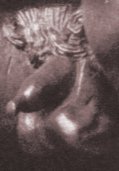 |
Unlike most satyrs, his penis is neither outsized nor erect. |
Wittelsbacher Ausgleichfonds, Munich
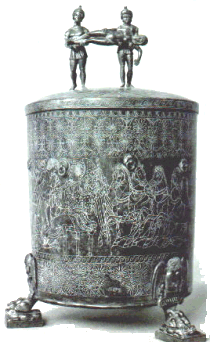 |
|
|
On this bronze Etruscan pot from Pareneste (Palestrina), wing-heeled Hermes brings three goddesses to Paris (seated) for his judgement. |
|
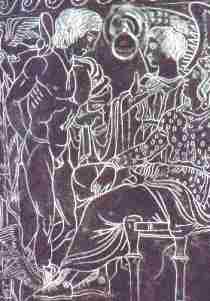 |
|
 |
The 63cm high pot is finely detailed |
late 4th C BCE,
Rome, Villa
Giulia
 |
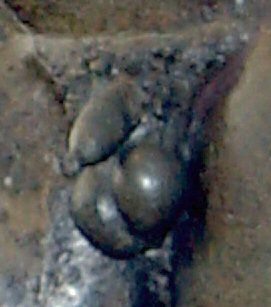 |
|
This larger-than-life bronze youth was fished up near the Greek island of Antikythera (along with the amazing Antikythera mechanism) in 1900. He was cast about 340 BCE, probably by Euphranor. He originally held something in his right hand, perhaps an apple. He has a prominent acroposthion and a visible corona. |
National Archaeological Museum, Athens
 |
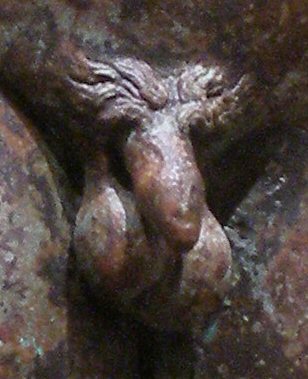 |
|
This bronze statue of a victorious athlete touching the olive wreath on his brow was fished out of the Adriatic Sea near Fano, Italy in 1964. It was probably made ~300-100BCE for a shrine at Olympia or Delphi. and plundered from Greece by Rome in a ship that was wrecked. Though realistic, his penis is small after the Greek ideal. Despite centuries of submersion and encrustation, what may be the realistic detail of a superficial dorsal vein has survived. |
- the Getty Villa,
claimed by Italy
 Metropolitan Musum of Art, New York
|
 Ny Carlsberg Glyptotek,
Copenhagen
|
|
The terracotta vase on the left (and presumably that on the right) was made in eastern Greece (probably on the island of Rhodes) 2500 to 2550 years ago. Phallus vases are a rare and distinctive kind of archaic Greek pottery. They were used to store perfumed oils, presumably for erotic or medicinal purposes. Archaic Greek potters sculpted vases in a wide variety of shapes, including human heads, legs, and animals. These "peniform" vases reflect a playfulness and unselfconsciousness about eroticism that recurs throughout Greek Art. |
|
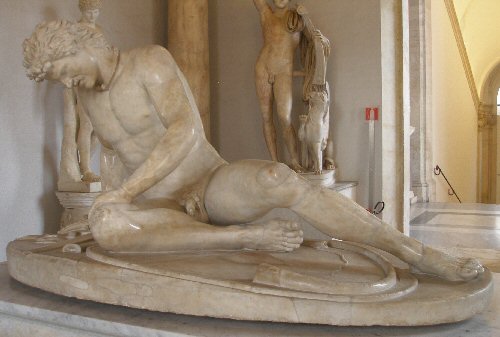 |
|
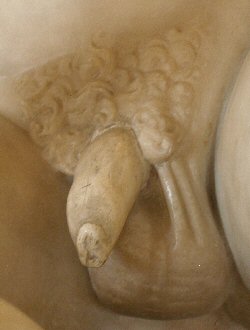 |
The Dying Gaul shows a Celt from Galatia, whom the Greeks regarded as barbarian, so they did not give him a classic small penis. The artist has shown his acroposthion, like his scrotum and public hair, in detail. |
Roman marble copy after a bronze original
attributed to Epigonos
from a commemorative group at Pergamon c. 230-220 BCE, Capitoline
Museum, Rome
|
Laoco÷n warned the Trojans against "Greeks bearing gifts". Poseidon sent sea serpents to strangle him and his sons as punishment. This group, thought to be made ~40-20 BCE by Agesander, Athenodoros and Polydorus from the island of Rhodes, was unearthed in 1506 near the site of the Domus Aurea of the Emperor Nero. |
|
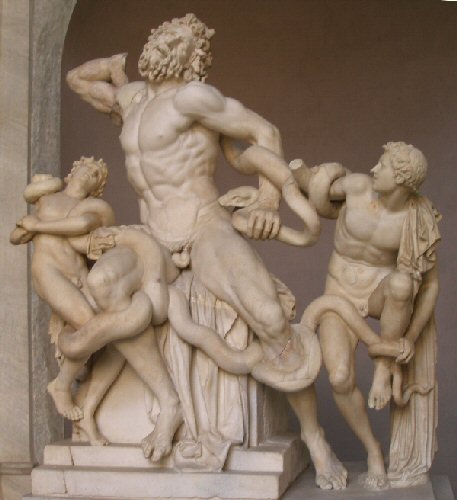 |
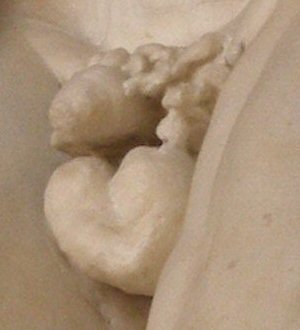 |
|
Laco÷n's acroposthion may be damaged, but his and his sons' penises are among the few in the Vatican Museum that have not been attacked with hammers or bowdlerised with drapes or figleaves. |
|
Vatican Museum
Depictions of erections follow.
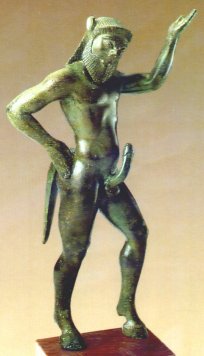 |
This 2500-year-old Greek satyr's penis is comically large, his foreskin still covering most of his glans. |
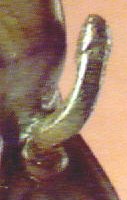
|
National Archaeological Museum, Athens
|
"Thou foster-child of silence and slow time...
- Keats |
|
|
|
|
This amphora, painted by Euthymides, son of Polias, over 2500 years ago, was found in Vulci in Etruria. |
|
|
|
|
 |
The reveller's small penis is typical. |
Staatiche Antikensammlungen, Munich
|
Why so small?
|
 |
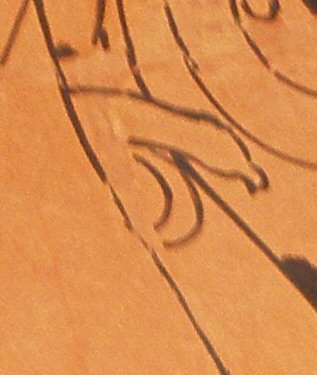 |
| This drunken man supporting himself on a stick and vomiting is presumably meant to be mocked. That may be why he is shown with a normal-sized penis, perhaps partically erect (but still fully covered). | |
- the Getty Villa
|
We should never assume that the Greeks, Romans and Etruscans considered images of penises as we do. They used them on amulets to ward off the evil eye, with perhaps no more thought for sexuality than we consider crossed fingers to be a Christian symbol. And the fertility of plants, beasts and people was ever an issue, since it could not be taken for granted or brought under human control by material means. |
 Roman gold amulet, 1st century CE, about 1 cm across London, British Museum |
 |
 "Herms" were common in ancient Greece, protecting the area if paid due reverence. |
|
Why always covered?
The Greeks considered only the glans, not the whole penis, to be obscene. In the gymnasium, men kept their glanses out of sight by tying a thong (kynodesme) around their foreskins, and Hellenised Jews sought foreskin restoration to make that possible. The "red-tipped" phallus that the Chorus of The Clouds disdained would have belonged to a circumcised Egyptian (leather intact phalluses were part of the costume in all comedies, including The Clouds). The glans was only shown on purely phallic images, such as those used in religious festivals. On those, the artists showed wrinkling to indicate the foreskin. |
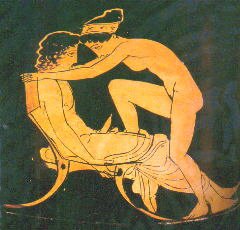 |
 Even on the point of penetration, erotic images showed the foreskin as fully forward. |
A red-figure jug by the Shuvalov painter, 2400
years old.
Berlin
Antikenmuseum
 |
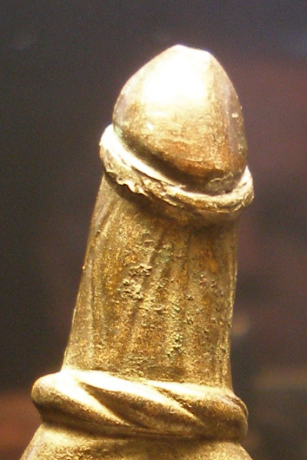 |
| This bronze "secret pilgrim" figurine conceals a phallus with retracted foreskin under his cucullus. The cucullus was worn by shepherds and hunters for protection from the rain, but also by high-ranking people travelling incognito. They were believed to be protected by the fertility god Priapus. Roman, 0-200 CE. | |
- The Thorvaldsen Museum, Copenhagen
Next (Pompeii)
Back to the Intactivism index page.
If any pictures are on this non-profit, educational site in breach of your copyright, please notify me and they will be removed.